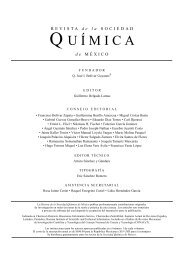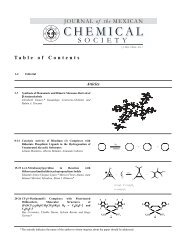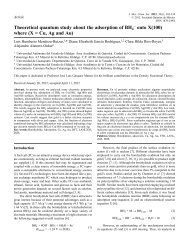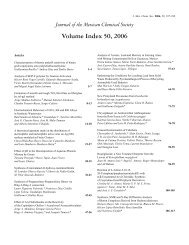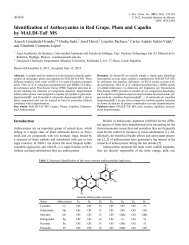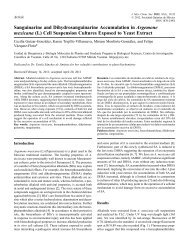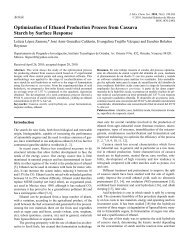SMQ-V047 N-002_ligas_size.pdf - Journal of the Mexican Chemical ...
SMQ-V047 N-002_ligas_size.pdf - Journal of the Mexican Chemical ...
SMQ-V047 N-002_ligas_size.pdf - Journal of the Mexican Chemical ...
Create successful ePaper yourself
Turn your PDF publications into a flip-book with our unique Google optimized e-Paper software.
Mechanism <strong>of</strong> Glutamate Neurochemistry: Electron Transfer and Reactive Oxygen Species 147<br />
entity, such as protein lysine, with elimination <strong>of</strong> ammonia,<br />
gives rise to <strong>the</strong> more stable imine 1b possessing a substituent<br />
on nitrogen. Alternatively, 1a could undergo hydrolysis to <strong>the</strong><br />
α-keto acid which also serves as precursor <strong>of</strong> (1b) by reaction<br />
with pri-amine [8]. We will explore possible ramifications relative<br />
to mode <strong>of</strong> action resulting from generation <strong>of</strong> conjugated<br />
imine (1b). Several common routes are generally available<br />
for imine and iminium syn<strong>the</strong>sis in biological systems, including<br />
oxidation <strong>of</strong> aliphatic amines and nonenzymatic condensation<br />
<strong>of</strong> carbonyl compounds with <strong>the</strong> pri-amino moiety <strong>of</strong><br />
basic amino acids in protein. Hence, <strong>the</strong>se transformations are<br />
applicable to Glu, making for relevance to our report. Regarding<br />
<strong>the</strong> iminium types, <strong>the</strong>y can also be derived simply by<br />
alkylation or protonation <strong>of</strong> imine.<br />
Syn<strong>the</strong>sis<br />
Cyclic iminocarboxylates were syn<strong>the</strong><strong>size</strong>d from α-ketoglutaric<br />
acid (2a), by condensing with hydrazine in methanol to<br />
yield cyclic ester 2 which on hydrolysis gave <strong>the</strong> cyclic<br />
iminocarboxylic acid (2c) in good yield. Similarly, acyclic<br />
types were prepared by condensing 2a with hydroxylamine in<br />
methanol to provide <strong>the</strong> corresponding methyl iminocarboxylate<br />
2d and <strong>the</strong> carboxylic acid 2e, which were separated by<br />
preparative thin layer chromatography (Scheme-1).<br />
Neurotoxicity<br />
Even before a decade ago, substantial data had built up pointing<br />
to OS as a factor in neuropathology by excitory amino<br />
acids, with Glu as <strong>the</strong> major effector [9].<br />
O<br />
OH<br />
NH 2 NH 2 . HCl<br />
CH 3 OH<br />
O<br />
OCH 3<br />
2a<br />
O<br />
O<br />
OH<br />
O<br />
NH 2 OH.HCl<br />
CH 3 OH<br />
N<br />
OH<br />
O<br />
HO<br />
O<br />
Prominent evidence includes generation <strong>of</strong> ROS and subsequent<br />
oxidative damage; radical scavengers and inhibitors<br />
prevent neuronal degradation. O<strong>the</strong>r suspected sources <strong>of</strong> OS<br />
are nitric oxide, peroxynitrite, calcium, iron, and activated<br />
ROS-generating enzymes.<br />
Two broad mechanisms were <strong>of</strong>fered to account for cell<br />
vulnerability, based on OS and excessive activation <strong>of</strong> Glu<br />
receptors. In one case, a sequential process pertains, whereas<br />
<strong>the</strong> o<strong>the</strong>r, <strong>of</strong> particular interest, entails interaction <strong>of</strong> <strong>the</strong> two.<br />
Four years later, increasing evidence supported <strong>the</strong> claim that<br />
excitotoxicity and oxidative stress play important roles in<br />
pathogenesis <strong>of</strong> both acute and chronic neurologic diseases<br />
[10]. The view was reiterated that <strong>the</strong> two effects may cooperate<br />
to induce neuronal degeneration. Hydroxyl radical levels<br />
and <strong>the</strong> volume <strong>of</strong> lesions were attenuated by spin trapping,<br />
pointing to radical scavenging. From our standpoint, <strong>the</strong> cooperative<br />
effect consists <strong>of</strong> ET entailing <strong>the</strong> receptor bound<br />
species. On <strong>the</strong> o<strong>the</strong>r hand, ET by imine might occur at ano<strong>the</strong>r<br />
site in keeping with <strong>the</strong> sequential scheme. The literature provides<br />
little discussion <strong>of</strong> specific, detailed pathways for OS generation<br />
from Glu, partly due to lack <strong>of</strong> working hypo<strong>the</strong>ses. We<br />
suggest that <strong>the</strong> α-imine metabolite may play a role in redox<br />
cycling to produce ROS, at least in toxicity. This approach is in<br />
harmony with various observations, “Although <strong>the</strong> activation <strong>of</strong><br />
Glu receptors is a key step in <strong>the</strong> sequence <strong>of</strong> events leading to<br />
neuronal degeneration, it is by no means all that is necessary…<br />
thus delayed neurotoxicity has been effectively dissociated<br />
from neuronal excitation...” [9]. A goodly number <strong>of</strong> o<strong>the</strong>r<br />
investigations document involvement <strong>of</strong> OS, <strong>of</strong> which several<br />
will be cited, including generation <strong>of</strong> ROS [11-13], induction <strong>of</strong><br />
lipid peroxidation [13a], DNA fragmentation [13b] and protection<br />
by antioxidants [13-15]. In addition, involving OS from<br />
Glu imine in neurotoxocity represents yet ano<strong>the</strong>r example in<br />
<strong>the</strong> widespread documentation <strong>of</strong> ROS from conjugated imine<br />
or iminium in toxic manifestations [3-7a].<br />
R<br />
H 2 N<br />
3<br />
N<br />
O<br />
M n+<br />
O<br />
n+<br />
M<br />
O<br />
N<br />
H<br />
N<br />
2b<br />
OCH 3<br />
2d<br />
OCH 3<br />
HO<br />
O<br />
O<br />
O<br />
O<br />
N<br />
H<br />
2c<br />
N<br />
O<br />
OH<br />
O<br />
OH<br />
2e<br />
N<br />
OH<br />
OH<br />
O<br />
Neurotransmission<br />
4<br />
Glu and related amino acids appear to be <strong>the</strong> major excitatory<br />
neurotransmitters in <strong>the</strong> brain with involvement in 40 % <strong>of</strong> <strong>the</strong><br />
synapses [9]. The importance <strong>of</strong> Glu is reflected by its presence<br />
in <strong>the</strong> CNS in relatively large quantities. An hypo<strong>the</strong>ti-





